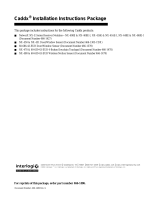
4 LightSYS™2 Quick Installer Guide
Table of Contents
Introduction ............................................................................................................................ 5
Selecting Mounting Location ................................................................................................ 5
Installing Hardware ................................................................................................................ 5
Main Unit — BUS Connection ........................................................................................... 5
1. Setting Bus Accessory ID Numbers ...................................................................... 6
2. Zone Inputs Connection ........................................................................................ 7
3. Wiring Auxiliary Devices ........................................................................................ 8
4. Wiring Internal Bell ................................................................................................ 9
5. Wiring Bell Tamper ................................................................................................ 9
6. Wiring Utility Output 1 to Activate Self-Power Devices ......................................... 9
7. Main Unit DIP Switch settings ............................................................................... 9
Connecting BUS Detectors ............................................................................................... 9
GSM Communication Module ......................................................................................... 11
IP Communication Module .............................................................................................. 11
Programming ........................................................................................................................ 11
Keys Menu Navigation .................................................................................................... 11
Programming Menu Concept .......................................................................................... 12
Access Installer Programming Menu ............................................................................. 12
1. First Time Power Up ............................................................................................ 12
2. Enter Installer Programming Mode...................................................................... 13
Identifying the connected devices ................................................................................. 13
1. Automatic Setting ................................................................................................ 13
2. Bus Test .............................................................................................................. 13
Zones Attributes .............................................................................................................. 13
Wireless Zones ................................................................................................................ 14
Step 1: Allocate a Wireless expander ......................................................................... 14
Step 2: Calibrate the Receiver .................................................................................... 15
Step 3: Allocating Wireless Zones ............................................................................... 15
Bus Detectors .................................................................................................................. 16
1. Programming bus detectors on the main bus ..................................................... 16
2. Programming Bus Detectors on a Bus Expander ............................................... 16
Communication Method .................................................................................................. 17
Report to Monitoring Station .......................................................................................... 17
Follow Me Destinations ................................................................................................... 17
General Settings .............................................................................................................. 18
1. Main System Timers ............................................................................................ 18
2. Set Up Users ....................................................................................................... 18
Keyfobs and 2-Way Slim Keypads ................................................................................. 18
Exiting Programming Mode ............................................................................................ 20
Connecting the LightSYS™2 to the Cloud .................................................................... 21
User Definitions and System Operation ............................................................................ 22
Testing the system ............................................................................................................... 22
Technical Specifications ..................................................................................................... 23
Troubleshooting ................................................................................................................... 24





















